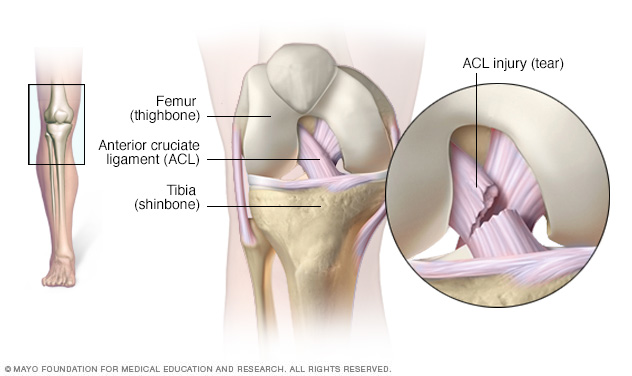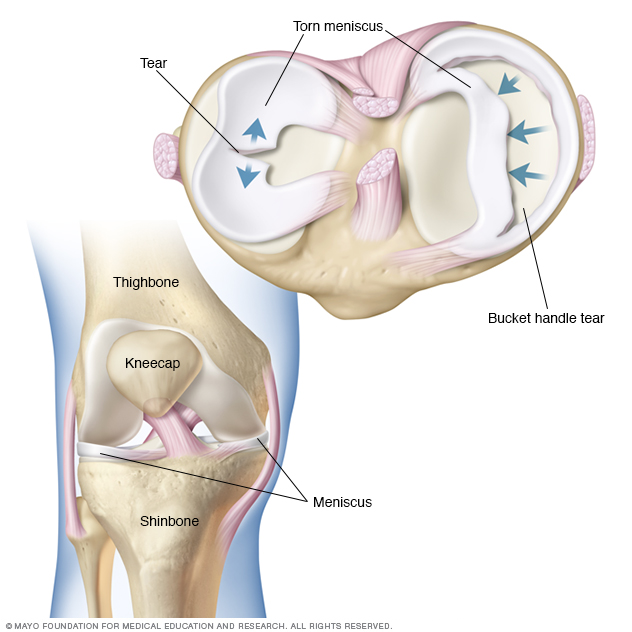A swollen knee occurs when excess fluid collects in or around your knee joint. Health care providers might refer to this condition as an effusion (uh-FU-zhun) in your knee joint.
A swollen knee may be the result of trauma, overuse injuries, or an underlying disease or condition. To find the cause of the swelling, your provider might need to test a sample of the fluid for infection, disease or blood from an injury.
Removing some of the fluid may help reduce the pain and stiffness associated with the swelling. Once the underlying cause is known, treatment can begin.
Symptoms
Signs and symptoms typically include:
- Swelling. The skin around your kneecap can puff up noticeably, especially when you compare the affected knee to your other one.
- Stiffness. When your knee joint contains excess fluid, you might not be able to bend or straighten your leg completely.
- Pain. Depending on the cause of the fluid buildup, your knee might be very painful — to the point that it's impossible to bear weight on it.
When to see a doctor
See your health care provider if self-care measures, such as ice and rest, don't improve symptoms. Seek immediate medical attention if one knee becomes red and feels warm to the touch compared with your other knee. This can be a sign of infection within the joint.
Causes
Many types of problems, ranging from traumatic injuries to diseases and other conditions, can cause a swollen knee.
Injuries
Damage to any part of your knee can cause excess joint fluid to accumulate. Injuries that can cause fluid buildup in and around the knee joint include:
- Torn ligament, particularly the anterior cruciate ligament (ACL)
- Cartilage (meniscus) tear
- Irritation from overuse
- Broken bones
Diseases and conditions
Underlying diseases and conditions that can produce fluid buildup in and around the knee joint include:
- Osteoarthritis
- Rheumatoid arthritis
- Infection
- Gout
- Pseudogout
- Bursitis
- Cysts
- Tumors

The anterior cruciate ligament (ACL) is one of the key ligaments that help stabilize the knee joint. The ACL connects the thighbone (femur) to the shinbone (tibia). It's most commonly torn during sports that involve sudden stops and changes in direction — such as basketball, soccer, tennis and volleyball.

The meniscus is a C-shaped piece of tough, rubbery cartilage that acts as a shock absorber between the shinbone and the thighbone. It can be torn if you suddenly twist your knee while bearing weight on it.
Risk factors
Factors that may increase your risk of a swollen knee include:
- Age. Your likelihood of developing a swollen knee related to arthritis increases as you age.
- Sports. People who participate in sports that involve twisting the knee, such as basketball, are more likely to experience the types of knee injuries that cause swelling.
- Obesity. Excess weight puts added stress on the knee joint, contributing to the tissue and joint overload and knee degeneration that can lead to a swollen knee.
Complications
Complications of a swollen knee can include:
- Muscle loss. Fluid in the knee can harm the working of your muscles and cause thigh muscles to weaken and atrophy.
- Fluid-filled sac (Baker cyst). The buildup of fluid in your knee can lead to the formation of a Baker cyst in the back of your knee. A swollen Baker cyst can be painful, but usually improves with icing and compression. If the swelling is severe, you might need to have fluid removed with a needle.
Prevention
A swollen knee is typically the result of an injury or chronic health condition. To manage your overall health and prevent injuries:
- Strengthen the muscles around your knee. Strong muscles around a joint can help ease pressure on the joint itself.
- Choose low-impact exercise. Certain activities, such as water aerobics and swimming, don't place continuous weight-bearing stress on your knee joints.
- Maintain a healthy weight. Excess weight contributes to the wear-and-tear damage that can lead to a swollen knee.
Diagnosis
Your health care provider is likely to start with a detailed history and physical examination. After that you likely will need tests to find out what's causing your swollen knee.
Imaging tests
Imaging tests can help show where the problem is located. Options include:
- X-ray. An X-ray can rule out broken or dislocated bones and determine if you have arthritis.
- Ultrasound. This test uses sound waves to check for disorders affecting the tendons or ligaments.
- MRI. Using radio waves and a strong magnetic field, MRI can detect tendon, ligament and other soft tissue injuries that aren't visible on X-rays.
Joint aspiration (arthrocentesis)
A needle is used to remove fluid from inside your knee. This fluid is then checked for the presence of:
- Blood, which may stem from injuries or bleeding disorders
- Bacteria that may be causing an infection
- Crystals common to gout or pseudogout
Treatment
Treatment varies depending on the cause of the swollen knee, its severity and your medical history.
Therapy
Physical therapy exercises can improve your knee's function and strength. In some situations, a knee brace may be helpful.
Surgical and other procedures
Treating the underlying cause of a swollen knee might require:
- Arthrocentesis. Removing fluid from the knee can help relieve pressure on the joint. After removing some of the joint fluid, your doctor might inject a corticosteroid into the joint to treat inflammation.
- Arthroscopy. A lighted tube (arthroscope) is inserted through a small incision into your knee joint. Tools attached to the arthroscope can remove loose tissue or repair damage in your knee.
Lifestyle and home remedies
Taking care of yourself when you have a swollen knee includes:
- Rest. Avoid weight-bearing activities as much as possible.
- Ice and elevation. To control pain and swelling, apply ice to your knee for 15 to 20 minutes every 2 to 4 hours. When you ice your knee, be sure to raise your knee higher than the level of your heart. Place pillows under your knee for comfort.
- Compression. Wrapping your knee with an elastic bandage can help control the swelling.
- Pain relievers. Over-the-counter medicines such as acetaminophen (Tylenol, others) or ibuprofen (Advil, Motrin IB, others) can help reduce your knee pain.
Preparing for an appointment
You may be referred to a health care provider who specializes in musculoskeletal and joint problems.
What you can do
- Write down your symptoms, and when they began.
- Write down your key medical information, including other conditions.
- Write down key personal information, including any major changes or stressors in your life.
- Make a list of all your medications, vitamins or supplements.
- Find out if anyone in your family has had an autoimmune disease.
- Ask a relative or friend to accompany you, to help you remember what the health care provider says.
- Write down questions to ask the provider.
Questions to ask your doctor
- What's the most likely cause of my symptoms?
- What kinds of tests do I need?
- What treatments are available?
- I have other health conditions. How can I best manage them together?
What to expect from your doctor
Your health care provider is likely to ask you a number of questions. Being ready to answer them may leave time to go over points you want to discuss in depth. You may be asked:
- Have you injured your knee recently? If so, describe the injury in detail.
- Does your knee "lock" or feel unstable?
- Has your knee felt warm or looked red? Do you have a fever?
- Do you play recreational sports? If so, what sports?
- Do you have any type of arthritis?
- Do you have a family history of autoimmune disease?
Copyright © 1998-2025 Mayo Foundation for Medical Education and Research (MFMER). All rights reserved.